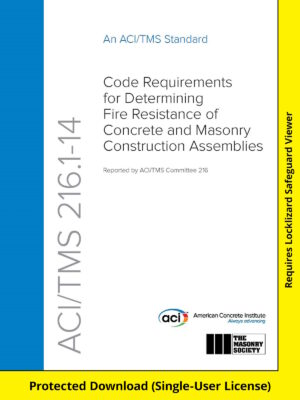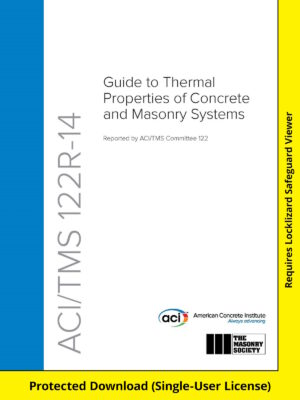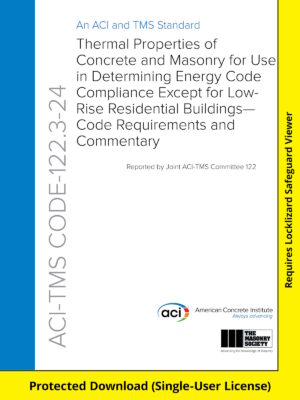Description
Fire resistance of building elements is an important consideration in building design. While structural design considerations for concrete and masonry at ambient temperature conditions are addressed by ACI 318 and TMS 402/ACI 530/ASCE 5, respectively, these codes do not consider the impact of fire on concrete and masonry construction. This standard contains design and analytical procedures for determining the fire resistance of concrete and masonry members and building assemblies. Where differences occur in specific design requirements between this standard and ACI 318 and TMS 402/ACI 530/ASCE 5, as in the case of cover protection of steel reinforcement, the more stringent of the requirements shall apply.
Keywords: beams; columns; compressive strength; concrete slabs; fire endurance; fire ratings; fire resistance; fire tests; masonry walls; modulus of elasticity; prestressed concrete; prestressing steels; reinforced concrete; reinforcing steel; structural design; temperature distribution; thermal properties; walls.
Table of Contents
CHAPTER 1—GENERAL
1.1—Scope
1.2—Alternative methods
CHAPTER 2—NOTATION AND DEFINITIONS
2.1—Notation
2.2—Definitions
CHAPTER 3—REFERENCED STANDARDS
CHAPTER 4—CONCRETE
4.1—General
4.2—Concrete walls, floors, and roofs
4.3—Concrete cover protection of steel reinforcement
4.4—Analytical methods for calculating structural fire resistance and cover protection of concrete flexural members
4.5—Reinforced concrete columns
4.6—Structural steel columns protected by concrete
4.7—Hollow structural steel columns filled with concrete
CHAPTER 5—CONCRETE MASONRY
5.1—General
5.2—Equivalent thickness
5.3—Concrete masonry wall assemblies
5.4—Reinforced concrete masonry columns
5.5—Reinforced concrete masonry lintels
5.6—Structural steel columns protected by concrete masonry
CHAPTER 6—CLAY BRICK AND TILE MASONRY
6.1—General
6.2—Equivalent thickness
6.3—Clay brick and tile masonry wall assemblies
6.4—Reinforced clay masonry columns
6.5—Reinforced clay masonry lintels
6.6—Expansion or contraction joints
6.7—Structural steel columns protected by clay masonry
CHAPTER 7—EFFECTS OF FINISH MATERIALS ON FIRE RESISTANCE
7.1—General
7.2—Calculation procedure
7.3—Installation of finishes





